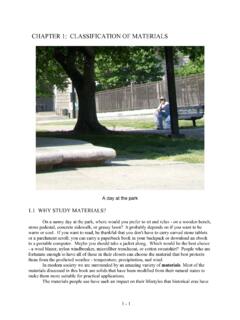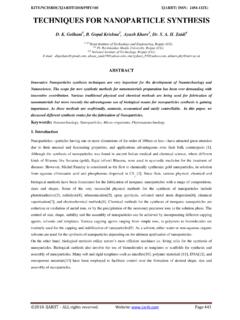Transcription of Titanium Carbide: Synthesis, Properties and Applications
1 Journal of Brilliant Engineering 2 (2021) 1-11 jy *Corresponding ( Orcid:0000-0003-1488-8699) Received 27 May 2020 Revised 16 July 2020 Accepted 19 July 2020 Brilliant Enginering 2 (2021) 1-11 2687-5195 2019 ACA Publishing. All rights reserved. 1 Review Titanium Carbide: synthesis , Properties and Applications Mohsen Mhadhbia and Miloud Drissb aLaboratory of Useful Materials, National Institute of Research and Physical-chemical Analysis, Technopole, SidiThabet 2020 Ariana, Tunisia bLaboratory of Sciences and Technology of Water, University of Mascara, 29000, Algeria. Keywords Abstract Titanium carbide, Properties , Microstructure, Applications , Nanostrcuture Composite materials are known in various forms.
2 The two distinctive constituents of these composite materials are the matrix material and the reinforcement material. A variety of materials are used as reinforcing material in composites Titanium carbide (TiC). TiC acquired considerable attention because of its unique Properties , which make it very attractive for advanced Applications . The current review summarizes various synthesis techniques to produce TiC nanocomposite and highlights the major industrial Applications of TiC. It was found that for certain techniques, the TiC powder has been synthesized directly, with different shapes and sizes, within a relatively very short time by eliminating a number of intermediate processes.
3 However, this review deals with the detailed literature survey carried out on the preparation of Titanium carbide powder, and also covers analyzes the results from the experiments conducted on the preparation of powder by the works of several researchers. Therefore, in-depth conclusions have been done on the research processes that are being carried out on improving the Properties of TiC reinforced composites. 1. Introduction For a decade, Titanium carbide (TiC) attracted considerable attentions due to its special characteristics like surface, shape, size, and interface. Among the ceramic materials, TiC is a well-known material reinforcing agent in metal composites due to its high melting point, elastic modulus, high Vickers hardness, low density, high flexure strength, good thermal conductivity, high resistance to corrosion and oxidation, and high thermal shock resistance.
4 In recent years, significant research activities were focused on the synthesis of TiC nanoceramic. Thus, throughout all of those developments, TiC always reveals special morphology to follow the further Applications . However, TiC can be synthesized using several methods, which will be discussed in depth in this review. Indeed, methods like traditional method, chemical vapor deposition (CVD), laser igniting self-propagating high-temperature synthesis (LISHS), sol-gel, self-propagating high-temperature synthesis (SHS), mechanical alloying (MA), etc will be presented in details.
5 Titanium carbide has been widely used for high-temperature Applications , such as aerospace, cutting tools, electronics, and chemicals. It is also used as reinforced particles in composites and hardening phase of super-alloys. In this review paper, we will focus on the influence of Titanium carbide synthesis methods on their Properties and Applications . 2. structure of Titanium carbide Titanium carbide, with chemical formula TiC, crystallizes in the cubic system: NaCl type with space group Fm3m (Z = 4). The lattice constant is a = nm. Ti atoms occupy the origin positions (0,0,0), however, C atoms are located in (1/2,1/2,1/2) positions.
6 Ti and C atoms are octahedrally coordinated with each other; consequently, Ti6C octahedra share edges [1]. Fig. 1 shows the schematic structure of Titanium carbide. As can be seen, illustrates the typical crystal structure of TiC [2]. C atoms occupy the octahedral positions. Thus, if viewed along the direction perpendicular to the planes, Ti and C atoms form a hexagonal shape, as presented in [3]. Figure 1. (a) Crystal structure of TiC, and (b) projection of Ti-C atoms along direction [2]. The smaller and black atoms are C atoms. 3. Summary of Properties of Titanium carbide Titanium carbide particles are effectively used as a reinforcement phase in composites due to its superior mechanical Properties , unique electrical Properties , and high temperature strength.
7 Fine grained TiC can improve yield strength of the composites through dispersion and grain size mechanisms and improve toughness by hindering crack propagation [4, 5]. Table 1 summarizes the electrical, mechanical, chemical, and thermal Properties of Titanium carbide at room temperature [6-10]. Mhadhbi et all. Brilliant Engineering 2 (2021) 1-11 2 Table 1. Properties of TiC at room temperature Electrical Properties Molecular Weight Density ( ) Electrical conductivity (106 ) Electrical resistivity ( .cm) Hall constant (10-4cm3 ) Magnetic susceptibility (10-6 emu/mol) Superconductive transition temperature (K) 30 68 -15 Mechanical Properties Vickers hardness (GPa) Young s modulus (GPa) Shear modulus (GPa) Flexure strength (MPa) Poisson's ratio 28-35 410-510 186 240-390 Chemical Properties Chemical symbol Color Electronic configuration Chemical composition (%) structure Lattice parameter (nm) Space group Pearson symbol TiC Silver gray Ti: [Ar]3d24s2 C.
8 [He]2s22p2 Ti content ( ) C content ( ) Cubic B1 (NaCl) Fm3m cF8 Thermal Properties Melting temperature ( C) Boiling temperature ( C) Thermal conductivity ( C) Enthalpy of formation ( ) Specific heat ( ) Thermal expansion ( 10-6/ C) 3067 4820 21 -184 4. Phase diagram of Titanium carbide Fig. 2 illustrates the binary phase diagram of Ti-C system [11]. The system consists of solids -Ti, -Ti, and a refractory monocarbide (TiC). As we can see, two other phases are present: liquid (L) and graphite (C). Thus, the system represents two eutectic and one peritectoid at 1646, 2776, and 920 C, respectively.
9 5. Fabrication processes of Titanium carbide Titanium carbide occurs in nature as a form of the very rare mineral khamrabaevite [(Ti,V,Fe)C]. Traditionally, TiC powders are commercially produced by the reaction of Titanium dioxide and carbon in the temperature range of 1700-2300 C for 10-24 h [12]. The synthesis of TiC powders by the carbothermal reduction demands a significant amount of energy. Thus, there have been several methods regarding synthesis of Titanium carbide [13, 14]. Every approach has varying features of morphology, particle size and distribution, condition of agglomeration, chemical purity, and stoichiometry [4].
10 Figure 2. Ti-C phase diagram [11] Carbothermal reduction Carbothermal reduction is a sample and inexpensive process that produces large amounts of powder and makes use of inexpensive precursor materials. These reduction processes are basically carried out at high temperatures; hence they are known as carbothermal reduction process [4, 15]. Almost all commercial productions primarily use a carbothermal reduction due to its low cost [4, 16]. There is currently no commercial powder production process to synthesize submicron TiC powder [17]. TiO2 was used as a raw material on an industrial scale due to its low cost and easy availability which reduces the cost of production and makes the process economical.


